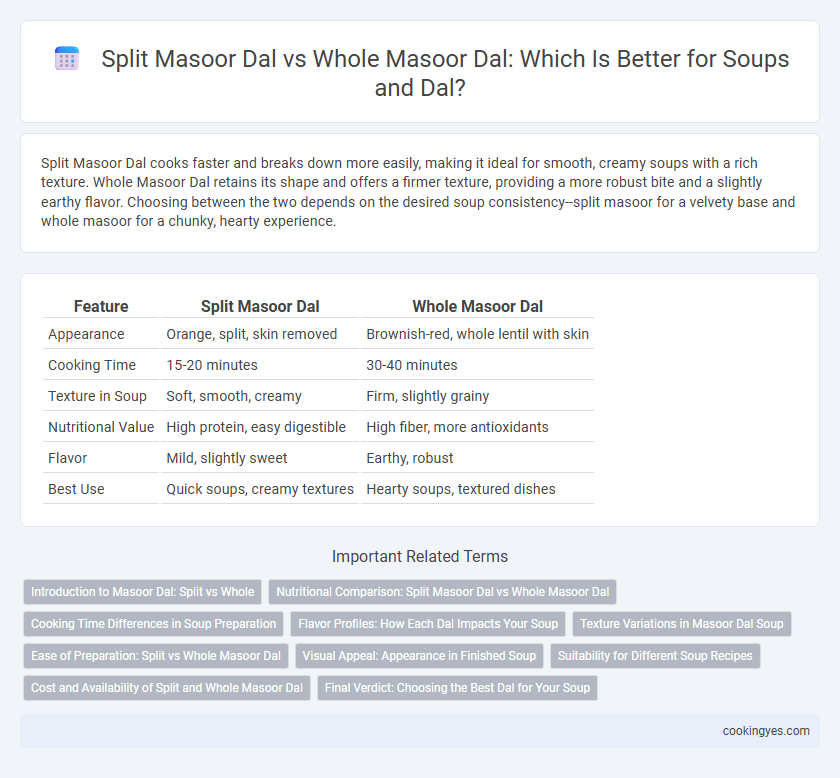Split Masoor Dal cooks faster and breaks down more easily, making it ideal for smooth, creamy soups with a rich texture. Whole Masoor Dal retains its shape and offers a firmer texture, providing a more robust bite and a slightly earthy flavor. Choosing between the two depends on the desired soup consistency--split masoor for a velvety base and whole masoor for a chunky, hearty experience.
Table of Comparison
| Feature | Split Masoor Dal | Whole Masoor Dal |
|---|---|---|
| Appearance | Orange, split, skin removed | Brownish-red, whole lentil with skin |
| Cooking Time | 15-20 minutes | 30-40 minutes |
| Texture in Soup | Soft, smooth, creamy | Firm, slightly grainy |
| Nutritional Value | High protein, easy digestible | High fiber, more antioxidants |
| Flavor | Mild, slightly sweet | Earthy, robust |
| Best Use | Quick soups, creamy textures | Hearty soups, textured dishes |
Introduction to Masoor Dal: Split vs Whole
Masoor Dal, known for its rich protein content and easy digestibility, is available in two main forms: split and whole. Split Masoor Dal cooks faster and has a softer texture, making it ideal for smooth soups and dals, while whole Masoor Dal retains its shape and offers a nuttier flavor with more fiber. Choosing between split and whole Masoor Dal depends on the desired texture and cooking time for your soup preparation.
Nutritional Comparison: Split Masoor Dal vs Whole Masoor Dal
Split Masoor Dal contains slightly higher protein (around 9 grams per 100 grams) and is easier to digest compared to Whole Masoor Dal, which retains more fiber (approximately 8 grams per 100 grams) due to its intact outer husk. Whole Masoor Dal provides a richer source of iron and B vitamins, promoting better energy metabolism, while Split Masoor Dal cooks faster and offers quick absorption of nutrients. Both versions are excellent sources of plant-based protein and essential minerals, making them nutritious choices for soups.
Cooking Time Differences in Soup Preparation
Split Masoor Dal cooks significantly faster than whole Masoor dal, typically requiring only 15 to 20 minutes in soup preparation due to its broken, husk-removed form that allows quicker water absorption and softening. Whole Masoor dal, with its intact skin, needs about 35 to 40 minutes to become tender, making it less ideal for quick soups but preferred for richer texture and visual appeal. Choosing split masoor dal optimizes cooking time without compromising nutritional content, enhancing soup preparation efficiency.
Flavor Profiles: How Each Dal Impacts Your Soup
Split Masoor Dal offers a smooth, creamy texture that dissolves quickly, enhancing the soup with a mild, slightly sweet flavor ideal for a delicate palate. Whole Masoor Dal retains its shape and imparts a nuttier, earthier taste, adding depth and a heartier consistency to soups. Selecting between split and whole masoor dal depends on the desired flavor complexity and texture intensity in your dish.
Texture Variations in Masoor Dal Soup
Split Masoor Dal produces a smooth, creamy texture in soup due to its quicker cooking and natural breakdown during boiling, making it ideal for light, velvety consistency. Whole Masoor Dal retains its shape better, resulting in a firmer texture with a slight bite, adding a hearty and rustic quality to the soup. The choice between split and whole Masoor Dal directly affects the soup's mouthfeel, with split dal offering a softer finish while whole dal provides more texture depth.
Ease of Preparation: Split vs Whole Masoor Dal
Split Masoor Dal cooks significantly faster than whole Masoor Dal, making it ideal for quick soups due to its reduced cooking time and softer texture. Whole Masoor Dal requires longer soaking and cooking, which can delay preparation and yield a firmer consistency in soup. Choosing split masoor dal enhances convenience without compromising on nutritional value, streamlining the cooking process for efficient meal preparation.
Visual Appeal: Appearance in Finished Soup
Split Masoor Dal provides a smooth, creamy texture in soup with a reddish-orange hue that enhances visual warmth, making the dish more inviting. Whole Masoor Dal retains its shape during cooking, resulting in a chunkier consistency with a muted brownish color that adds rustic charm to the presentation. The choice between split and whole Masoor Dal significantly affects the soup's appearance, with split dal offering a polished finish and whole dal delivering a hearty, textured look.
Suitability for Different Soup Recipes
Split Masoor Dal cooks faster and breaks down easily, making it ideal for smooth, creamy soups like pureed lentil or tomato-lentil blends that require a velvety texture. Whole Masoor Dal retains its shape and firmness better, providing a heartier bite perfect for chunky soups or stews where distinct lentil pieces add texture and visual appeal. Choosing between split and whole Masoor Dal depends on whether the soup recipe demands a smooth consistency or a more substantial, textured lentil presence.
Cost and Availability of Split and Whole Masoor Dal
Split Masoor Dal is generally more affordable and widely available in supermarkets and local markets compared to Whole Masoor Dal, which can be slightly pricier due to less processing and longer shelf life. Split Masoor Dal cooks faster, making it a cost-effective option for quick meals like soup, while Whole Masoor Dal, although nutritious, requires longer cooking time, impacting fuel cost and convenience. Both types offer similar nutritional benefits, but availability and price make Split Masoor Dal a preferred choice for soup preparations.
Final Verdict: Choosing the Best Dal for Your Soup
Split Masoor Dal cooks faster and breaks down easily, creating a smooth, creamy texture ideal for soups. Whole Masoor Dal retains its shape, providing a firmer bite and more pronounced flavor in brothy soups. For the best soup experience, choose split masoor dal for velvety consistency or whole masoor dal for a hearty, textured dish.
Split Masoor Dal vs Whole Masoor Dal for Soup Infographic

 cookingyes.com
cookingyes.com